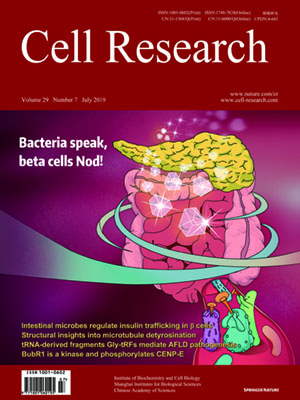Volume 29 Issue 7, July 2019: 579-591 | Open Access
ORIGINAL ARTICLES
AIF-regulated oxidative phosphorylation supports lung cancer development
Shuan Rao 1,2, Laura Mondragón 3,4,5,6, Blanka Pranjic2, Toshikatsu Hanada2, Gautier Stoll 3,4,5,6,7, Thomas Köcher8, Peng Zhang9,Alexander Jais10, Alexander Lercher 11, Andreas Bergthaler11, Daniel Schramek 12, Katharina Haigh 13,14,15, Valentina Sica 3,4,5,6,Marion Leduc 3,4,5,6, Nazanine Modjtahedi 16,17,18, Tsung-Pin Pai2, Masahiro Onji2, Iris Uribesalgo2, Reiko Hanada2, Ivona Kozieradzki2,Rubina Koglgruber2, Shane J. Cronin2, Zhigang She19, Franz Quehenberger 20, Helmut Popper 21, Lukas Kenner 22,23 ,Jody J. Haigh 13,14,15, Oliver Kepp 3,4,5,6, Malgorzata Rak24, Kaican Cai 1, Guido Kroemer 3,4,5,6,25,26,27 and Josef M. Penninger 2,28
1 Department of Thoracic Surgery, Nanfang Hospital, Southern Medical University, Guangzhou, Guangdong, China; 2IMBA, Institute of Molecular Biotechnology of the Austrian Academy of Sciences, 1030 Vienna, Austria; 3Equipe 11 labellisée Ligue contre le Cancer, Centre de Recherche des Cordeliers, 75006 Paris, France; 4INSERM, U1138, 75006 Paris, France; 5Université Paris Descartes, Sorbonne Paris Cité, Paris, France; 6Metabolomics and Cell Biology Platforms, Gustave Roussy Cancer Campus, 94805 Villejuif, France; 7Université Sorbonne, 75006 Paris, France; 8Vienna Biocenter Core Facilities, 1030 Vienna, Austria; 9Medical Science Research Center, Zhongnan Hospital of Wuhan University, Wuhan, Hubei, China; 10Department of Neuronal Control of Metabolism, Max Planck Institute for Metabolism Research, Cologne, Germany; 11 Research Center for Molecular Medicine of the Austrian Academy of Sciences, Vienna, Austria; 12 Lunenfeld-Tanenbaum Research Institute, Mount Sinai Hospital, 600 University Avenue, Toronto, Canada; 13 Vascular Cell Biology Unit, Department for Molecular Biomedical Research, VIB, Ghent, Belgium; 14 Department of Biomedical Molecular Biology, Ghent University, Ghent, Belgium; 15 Department of Pharmacology and Therapeutics, Rady Faculty of Health Sciences, University of Manitoba, Winnipeg, Canada; 16 Gustave Roussy Cancer Campus, Villejuif, France; 17 Faculty of Medicine, Université Paris-Saclay, Kremlin-Bicêtre, France; 18 INSERM, U1030 Villejuif, France; 19 Department of Cardiology, Renmin Hospital of Wuhan University, Wuhan, Hubei, China; 20 Institute for Medical Informatics, Statistics and Documentation, Medical University Graz, Graz, Austria; 21 Center for Diagnostics and Research in Molecular Biomedicine, Pathology Institute for Diagnostics and Research, Medical University Graz, Graz, Austria; 22 Department of Experimental Pathology and Pathology of Laboratory Animals, Medical University Vienna and University of Veterinary Medicine Vienna, Vienna, Austria; 23 Ludwig Boltzmann Institute for Cancer Research (LBI-CR), Vienna, Austria; 24 INSERM, UMR1141, Hopital Robert Debre 48 Boulevard Serurier, 75019 Paris, France; 25 Pôle de Biologie, Hôpital Européen Georges Pompidou, AP-HP, Paris, France; 26 Suzhou Institute for Systems Biology, Chinese Academy of Sciences, Suzhou, Jiangsu, China; 27 Department of Women’s and Children’s Health, Karolinska Institute, Karolinska University Hospital, Stockholm, Sweden and 28 Department of Medical Genetics, Life Sciences Institute, University of British Columbia, Vancouver, Canada
Correspondence: Guido Kroemer (kroemer@orange.fr) or Josef M. Penninger (josef.penninger@imba.oeaw.ac.at)These authors contributed equally: Shuan Rao, Laura Mondragón
Cancer is a major and still increasing cause of death in humans. Most cancer cells have a fundamentally different metabolic profile from that of normal tissue. This shift away from mitochondrial ATP synthesis via oxidative phosphorylation towards a high rate of glycolysis, termed Warburg effect, has long been recognized as a paradigmatic hallmark of cancer, supporting the increased biosynthetic demands of tumor cells. Here we show that deletion of apoptosis-inducing factor (AIF) in a KrasG12D-driven mouse lung cancer model resulted in a marked survival advantage, with delayed tumor onset and decreased malignant progression. Mechanistically, Aif deletion leads to oxidative phosphorylation (OXPHOS) deficiency and a switch in cellular metabolism towards glycolysis in non-transformed pneumocytes and at early stages of tumor development. Paradoxically, although Aif-deficient cells exhibited a metabolic Warburg profile, this bioenergetic change resulted in a growth disadvantage of KrasG12D-driven as well as Kras wild-type lung cancer cells. Cell-autonomous re-expression of both wild-type and mutant AIF (displaying an intact mitochondrial, but abrogated apoptotic function) in Aif-knockout KrasG12D mice restored OXPHOS and reduced animal survival to the same level as AIF wild-type mice. In patients with non-small cell lung cancer, high AIF expression was associated with poor prognosis. These data show that AIF-regulated mitochondrial respiration and OXPHOS drive the progression of lung cancer.
https://doi.org/10.1038/s41422-019-0181-4
FULL TEXT | PDF
Browse 1144


